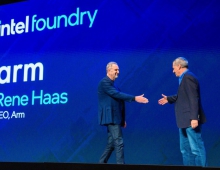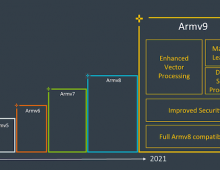
New ARM Mali-V61 And Mali-G51 Processors Launched To Offer Richer Mobile VR and 4K Streaming Experiences
ARM has launched two new products -- the Mali-V61 video processing unit (VPU) for real-time 4K120 video performance with efficiency and the Mali-G51 graphics processing unit (GPU), ARM’s most area-efficient and energy-efficient GPU to date. In developing Mali-V61, ARM continued to take an alternative approach to the standard video processor which tends to target a specific codec or a very limited selection. Instead, ARM developed a single, unified video solution which controls all the necessary features of the relevant codecs through firmware with all pixel processing handled by specified hardware blocks. ARM's firmware is controlled through a single API and we currently provide reference drivers based on the latest Android releases along with a host interface specification.
ARM says that the Mali-V61 delivers the most efficient 4K live streaming for real-time video applications such as Facebook Live and Periscope. The live streaming advantages of the Mali-V61 are enabled by a 50 percent bit-rate saving over previous generation codecs to enable efficient transmission of high definition content. The Mali-V61 also scales from 1080p60 on a single core, up to 4K120 on multiple cores.

The Mali-V61 VPU is the only multi-standard codec featuring high quality HEVC and VP9 encode in a single scalable IP block. T he video processor’s flexibility in handling multiple encode/decode streams makes it a solution for a range of important use cases. Two-way, real-time video communication is an increasing use case, whether in more formal video conferencing applications or the growing range of video chat applications that are now prevalent. The complexity required to simultaneously handle multiple video streams from different devices, locations and performance points often means that there are serious compromises in the quality of the final video output. ARM says that Mali-V61 is able to efficiently handle all of these streams and allocate just the required amount of bandwidth in order to retain the maximum possible video quality.
The Mali-V61 is configurable to enable multiple levels of use of the video IP whilst retaining the same quality encoding and decoding performance. ARM's parters can take into account considerations such as the preferred resolution and frame rate to be supported and whether they want to enable encode or offer only decode capability, for example if they are producing a video player without a camera. Partners can also design their configuration based on whether or not they want to support 10-bit and 8-bit video, or just 8-bit, as well as if they want to support all video codecs, or just a subset.
A new version of one of ARM’s top bandwidth saving technologies, ARM Frame Buffer Compression (AFBC) has also been adopted for the Mali-V61 VPU as well as the newly released Mali-G51 GPU. This latest version of AFBC is backwards compatible while advances in this technology provide efficiency across the full Mali Multimedia Suite of products.
Based on ARM’s new Bifrost architecture which has been updated to include a redesigned texturing unit with double the throughput, the Mali-G51 GPU is bringing premium graphics to mainstream mobile devices.
Mali-G51 is ARM’s smallest and most efficient Vulkan-enabled GPU for screen resolutions up to 4K. The processor delivers up to 60 percent more performance per mm2 and is up to 60 percent more energy-efficient than its predecessor, the Mali-T830 GPU. Mali-G51 is also 30 percent smaller, reducing the cost of manufacturing high-volume chips while enabling it to address more high-performance use cases.

Bifrost’s low level instruction set, which gives control to the compiler, has been further optimized for Mali-G51 and specifically rebalanced for power sensitive graphics workloads. Not only that, but a new dual-pixel shader core has been implemented to double texel and pixel rates and can be used asymmetrically with a uni-pixel shader core in order to access even further configurability.
Virtual reality (VR) is one of the more demanding of today’s use cases when it comes to the burden it places on a mobile system. To ensure a fully immersive experience in VR gaming requires extensive power and performance optimization. This however, doesn’t mean that you can only join the virtual world by purchasing top of the line devices. Low power VR is becoming a market segment all of its own and is facilitating some of the arguably more useful, every day virtual interactions.
ARM says that Mali-G51 can power 'Virtual Spaces,' referring to virtual environments that don’t require the fully interactive, highly reactive elements of AAA VR gaming. They are finite environments that can support interactive elements, like the people within them, whilst keeping the surroundings static and therefore minimizing GPU workload.
Socially, virtual spaces allow you to meet up with friends in comfortable surroundings and talk face to face, without ever leaving your sofa.
Both the Mali-V61 VPU and the Mali-G51GPU are designed to interact as part of the wider Mali Multimedia Suite and ARM Cortex-A processors. The Mali Multimedia Suite includes graphics, video and display processors.
Mali-V61 and Mali-G51 are available to license now and both processors support ARM initiatives such as the new version, v1.2, of ARM Frame Buffer Compression (AFBC), and ARM TrustZone technology to enable a secure foundation for consumer products.





















